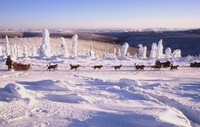Outrageous and extraordinary Yukon events

Yukoners are a lively bunch and like to keep active year-round so it's not surprising that the Yukon calendar of events is bursting with festivals and special events. Any time more than two Yukoners get together, it's a party, so just imagine the possibilities for a good time.
Burning Away the Winter Blues
Participants in Burning Away the Winter Blues take part in a torch-lit procession along a riverfront path, led by a giant effigy of the Winter Blues, uniquely created each year by a local artist. The procession moves onto a candle-lit path through the woods, finally reaching a roaring bonfire. Drummers drum, chanters chant and fire-spinners spin; people visit and talk and near the end of the evening, when the effigy is tossed into the fire, a cheer goes up. Along with the effigy, a bag is thrown into the fire containing paper representations of the participants' winter blues. The blues that are burned can be everything from chemistry notes - to symbolic last packages of cigarettes - to love letters - to just a few lines on a piece of paper describing what's bugging you. The ceremonial burning of the blues is a symbolic gesture to bring closure to winter and welcome spring. The evening ends on a hopeful note as the dragon of spring dances, and sunflower seeds, representing sun and spring and hope, are passed out by young children. This year, people could also email or mail in their blues ahead of time to be burned away on March 22nd.
Yukon Sourdough Rendezvous Festival
Near the end of February, after a few months of sub-zero temperatures, Yukoners get a crazed look in their eyes and break out in grins for no apparent reason. It's time to cut loose and take part in the best-known cure for cabin fever, the annual Yukon Sourdough Rendezvous Festival. A kind of Mardi Gras in mukluks, "Rendezvous" is an entire week of wintertime silliness and celebration. Downtown Whitehorse assumes a carnival atmosphere as streets are closed for games, concerts and snow carving, and individuals test their skills and stamina in northern contests like chainsaw chucking, axe throwing or flour packing. Even the military joins in the fun, with Canadian and American aircraft putting on the annual Rendezvous Air Show at Whitehorse International Airport.
Yukon Quest International Sled Dog Race
This legendary dogsled race follows a 1,000-mile route through the vast wilderness between Whitehorse, Yukon, and Fairbanks, Alaska. Most front-runners complete the rigorous Yukon Quest journey in 12 days. Dramas unfold on the trail daily—teams running neck and neck, racers helping one another out of perilous situations, exhausted mushers seeing apparitions on the trail. There are other long-distance sled dog races, including the higher profile Iditarod, but the Yukon Quest takes one of the most isolated, rugged routes on the continent, earning the moniker 'the toughest sled dog race in the world'. This international event attracts about 30 dog teams from around the world, competing for about $125,000 U.S. in prize money. Media and visitors gather in Dawson City, the halfway point and mandatory layover, to see and hear first-hand the rigours of the race.
Kluane Chilkat International Bike Relay
During the long sunny days of June, more than a thousand cyclists wind their way through the high mountain passes of the scenic Haines Highway in an epic race from Haines Junction, Yukon to Haines, Alaska. Sometimes cyclists report seeing a grizzly bear ambling across the road, and some years the changeable weather offers up sleet in the pass and sun at the coast.This incredibly fun team relay (teams of 8, 4 and 2) attracts both serious and recreational competitors, some coming from as far away as Europe and the southern U.S. The 155 mile route passes through Kluane National Park and Tatshenshini-Alsek Provincial Park to the coastal Alaskan town of Haines.
Yukon River Quest Canoe & Kayak Race
The Yukon River Quest is the 'summer cousin' of the wintertime Yukon Quest. It's the longest endurance marathon canoe race in the world, and it attracts some of North America's top long-distance paddlers. Canoes and kayaks take to the Yukon River at Whitehorse trying to be the first boat to Dawson City, 444 miles downriver. Top finishers usually arrive within three days, while others take a bit more time to enjoy the historic Gold Rush route.
Dawson City Music Festival
On this warm summer day beneath the giant red and white candy-striped tent a vibrating dance floor is packed with folks gyrating with hoola hoops or with kids hoisted onto their shoulders. The celebration spills outside where the music mingles with the smell of freshly cut lawn and sizzling bar-b-ques in the open-air beer garden. Incense drifts from a wee village of New Age vendor stalls. It's the Sunday afternoon Pot Luck jam session on the main stage of the annual Dawson City Music Festival (DCMF). The truth is, the whole town is having a party.
Background on Yukon
Situated in the upper Northwest corner of Canada, next to Alaska, the Yukon is Canada's most accessible northern destination. Home to Canada's highest mountain (Mount Logan) and one of the largest non-polar icefields located in Kluane National Park - a UNESCO World Heritage site - breathtaking doesn't describe the vastness, or the beauty!
The Yukon is one of North America's major wilderness attractions; close to 80 percent remains pristine wilderness with 5,000-metre peaks, forested valleys, unspoiled waters and untamed wildlife. Roughly the size of France at 483,000 square kilometers, The Yukon is home to more than 160,000 caribou, 70,000 moose, 22,000 mountain sheep, 7,000 grizzly bears, 10,000 black bears and 250 species of birds… and only 34,000 humans!
Windows on the Wild offer various types of packages to discover the Yukon. For more information, visit windowsonthewild.com.

